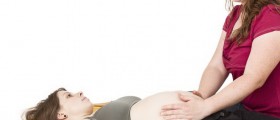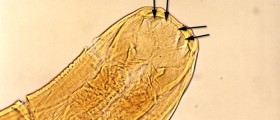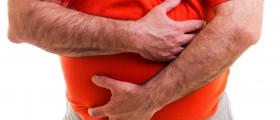Usually, the underlying cause of female abdominal pain is some kind of a problem with the female reproductive organs. Based on that, it can be concluded that abdominal pain in women is more common than in men. The most frequent cause of female abdominal pain is connected with the menstrual period and labor. Of course, if pain lasts more than an hour, it should be taken with precaution and a woman should visit her gynecologist.
Reproductive System Cause of Abdominal Pain in Women
In order to understand and comprehend what might be the cause of abdominal pain, it is important to know where the female organs are. For example, if a woman is having pain in the right lower abdomen, the cause of the pain could be determined by discovering which organ is affected.
Organs in the central lower abdomen of a woman are the uterus, bladder, central ends of the fallopian tubes, cervix, upper part of the vagina, ends of round ligaments, and part of a mobile gut. Ovaries and external parts of the fallopian tubes are located in the right/left side of the lower abdomen. Finally, the appendix, a common source of pain in both women and men, is located in the lower right part of the abdominal cavity, close to the right ovary.
Menstrual pain is pain that occurs a few days before a period. It can be mild to moderate. Paracetamol or Panadol can help to overcome this pain. On the other hand, mid-cycle pain is a type of abdominal pain that comes suddenly, two weeks before the period. It can appear every two or three months.
Another common cause of lower abdominal pain is PID or pelvic inflammatory disease. Symptoms are pain in the abdomen, painful intercourse and such pain may happen with or without fever. Treatment for PID is prescribed by a doctor.
Ectopic pregnancy is a state when the pregnancy is taking place outside the uterus. It causes severe abdominal pain. Diagnosis of ectopic pregnancy is confirmed after a detailed analysis and only then an emergency operation is necessary. However, this problem can be resolved by using special medications. A miscarriage can be recognized when there is vaginal bleeding and abdominal pain. It happens within first ten weeks of pregnancy.
Among women fibroids may be the cause of abdominal pain. Fibroids are abnormal growths of muscles of the uterus that can form hard lumps in the wall or inside the womb. They can be detected by a routine ultrasound. If there is a suspicion regarding any of the above mentioned conditions, the best thing to do is to see a doctor and ask for medical advice.
Some other causes that can also relate to abdominal pain are appendicitis, constipation, urinary tract infection, labor pain, false labor during middle and late pregnancy, polycystic ovarian syndrome, ovarian cyst, ovarian cancer, irritable bowel disease, and many others.
- This report is a secondary analysis of prospective and retrospective symptom severity and impact data, collected on 242 women with IBS, aged 18-48, who were studied between 1997 and 2004.
- On the daily diary, intestinal gas was the most frequent IBS symptom with subjects reporting at least minimal intestinal gas on 74% of days and moderate or worse severity on 27% of days. Abdominal pain occurred at least minimally on 62% of days. Diarrhea was the least common.
- Across women, abdominal pain was most strongly related to life impact variables and QoL, followed by intestinal gas and bloating.
- Analysis of day-to-day variation within women showed that abdominal pain was most strongly correlated with daily life impact variables and constipation had the weakest correlation.
- While diarrhea had a lower correlation with life impact, this was due to the low prevalence of diarrhea. When it occurs, diarrhea has a large impact. Partial correlation analysis showed that the impact of diarrhea is independent of abdominal pain.
Infection Can Cause Pain in the Abdomen
Intestinal infections are usually caused by viruses, yeast, bacteria, intestinal parasites, fungi or perhaps poor personal hygiene. All these harmful microorganisms can be put in the group of pathogens. They are harmful because they infect the urinary and digestive tract and can sometimes even be fatal.
Yeast infection is specific because it cannot be observed until the yeast starts converting to fungi. The conversion is usually triggered by poor dietary habits and prolonged or repeated intake of antibiotics which creates environment that is conducive in nature. Intestinal infection is usually caused by the food one ingests. The food can be contaminated by various types of bacteria if a person does not handle it properly. Severe abdominal cramps are one of the common symptoms of intestinal infections and they are usually caused by bacteria. Nausea is, of course, one of the most frequent intestinal infection symptoms and it is a state in which a person feels an aversion even to the most loved types of food. Diarrhea also happens quite often and is causes by pathogens which can be present in the intestinal tract. Diarrhea can be very dangerous because it leads to dehydration which can be severe and life-threatening.
Intestinal infections can sometimes be caused by parasites present in the intestinal tract and that condition can often lead to constipation. Some types of worms are simply big enough to block the intestinal system and cause difficulties in bowel movement. Parasites can also dig into the lining of the intestinal walls in order to attach themselves more firmly and by doing so they can trigger substantial pain. Intestinal infections can also irritate a person to a point where he or she experiences sleep disorders.
In normal conditions the human body eliminates toxic substances during sleep but parasites in the intestinal tract make this rather difficult. The pathogens steal all the nutrients and impair the immune system which can potentially lead to anemia and other types of health problems.
All in all, many health problems may lead to pain in lower abdomen, especially in females. Therefore, it is best to know the possible culprits behind your pain and seek medical assistance timely.
- www.nhs.uk/conditions/pelvic-pain/
- www.betterhealth.vic.gov.au/health/conditionsandtreatments/ovulation-pain
- Photo courtesy of Marco Verch Professional Photographer via Flickr: www.flickr.com/photos/30478819@N08/51095591402


















Your thoughts on this
Loading...